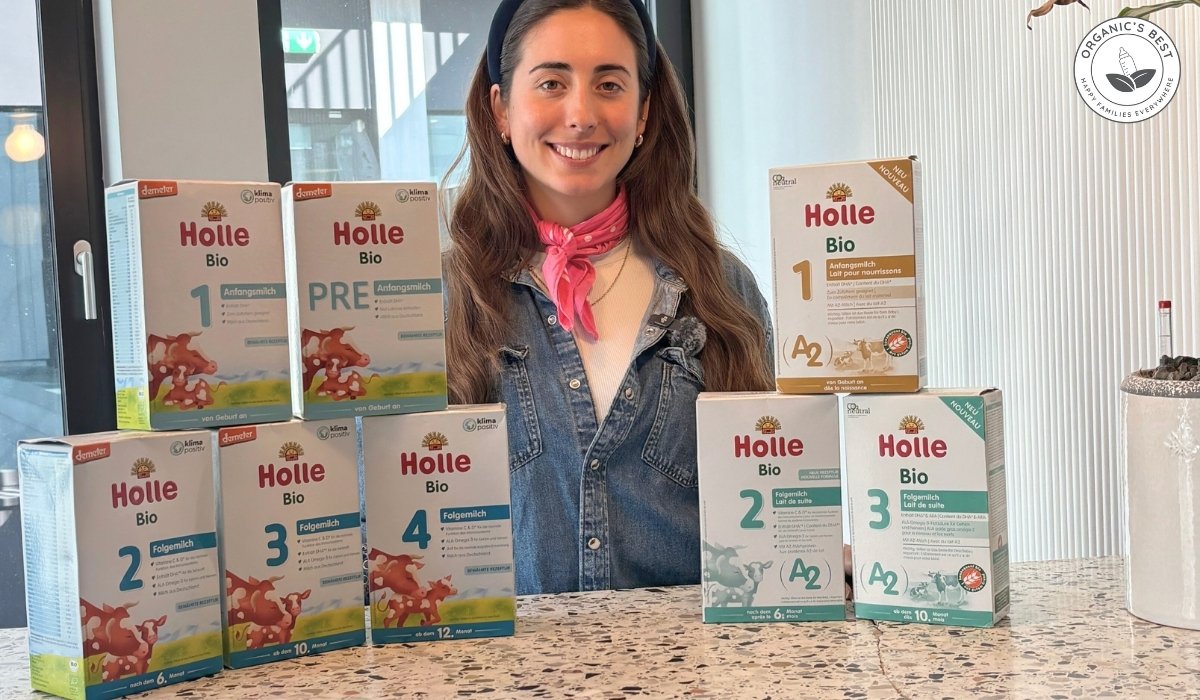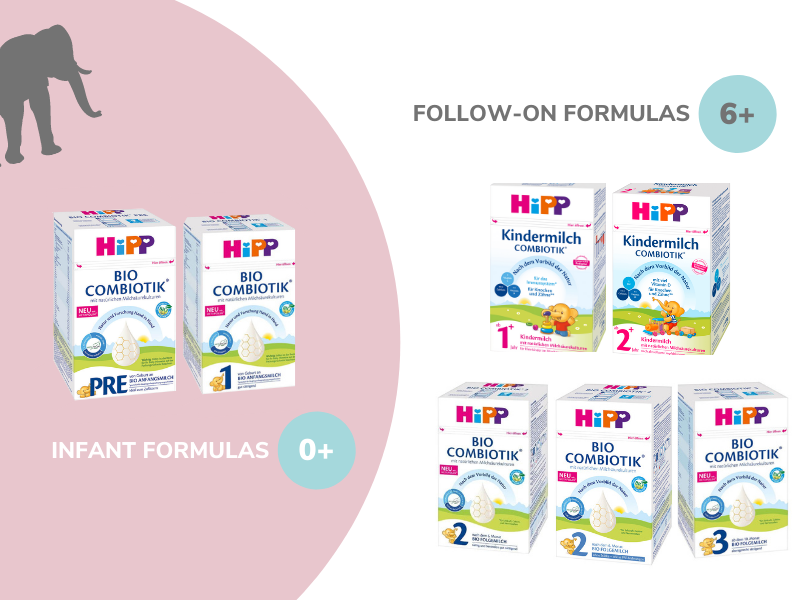Click to Get 2 FREE Boxes/Cans
Only New Customers! Click HERE to Get 2 Extra Boxes/Cans for Free With Your First Order.
BABY FORMULA
Offering new parents top-quality European infant formula from renowned brands like HiPP, Holle, Kendamil, and more. If you’re uncertain about which product to choose, our Formula Finder can help you make the best decision for your baby.
Baby Food
Offering new parents a premium selection of European baby foods, including jars, pouches, cereals, and snacks from esteemed brands like HiPP and Holle.
European Baby Formula Stages Made Simple
by Agustina Fernandez May 10, 2022 15 min read


Table of Contents
- What Are Formula Stages and What's Their Purpose?
- What are the Differences Between Stages 1, 2, and 3?
- Stage 1 Infant Formula
- Stage 2 Follow-On Formula
- Stage 3 Follow-On Formula
- When Should I Change Formula Stages?
- Differences in Stages by Brand
- Holle Organic Cow’s Milk Formula
- Holle Organic Goat’s Milk Formula
- HiPP German Bio Combiotic Formula
- HiPP Dutch Bio Combiotic Formula
- Kendamil Organic Cow’s Milk Formula
- Conclusion
It is indisputable that breastmilk is best for feeding your little one during their first year of life. Of course, some women may be unable or choose not to breastfeed. When this happens, have no fear—baby formulas are here!
Baby formulas are specially designed with care to give your little one safe, nutritious milk that promotes healthy growth and development. These formulas come in different stages to best meet your baby's nutritional needs as they grow up.
Unfortunately, choosing a formula for your baby is not always an easy feat; plus, it doesn’t help that different baby formula manufacturers have come up with all sorts of names to describe formulas made for babies of a particular age.
Depending on which brand you're looking at, you may see anything from first, second, third, or fourth milk, simple labels like PRE, 1, 2, 3, or 4, or in the case of many European formulas, infant and follow-on milk. Navigating the world of baby formulas can be overwhelming at first glance. That's why we’re here to help you choose the right formula stage for your baby!
What Are Formula Stages and What's Their Purpose?

The good news is that no matter what a brand may call its formula stages, in Europe, all baby formulas fall into one of two categories: infant formula or follow-on formula.
According to the European Commission, infant formula and follow-on formula are designed to satisfy the nutritional requirements of babies under 12 months of age.
Regardless of which formula your baby takes, the European Food Safety Authority has set strict regulations for the energy levels and macro and micronutrients in baby formulas to ensure your little one has all the nutrients they need!
Feeding infant formula exclusively will meet babies' nutritional needs until the appropriate introduction of complementary feeding. Your little one can usually continue to drink their infant formula throughout their first year of life, even when they're introduced to solids around six months.
Follow-on formulas, on the other hand, are intended to be fed alongside appropriate complementary feeding. As such, this formula should not be used until the six-month mark. Follow-on formula represents the primary liquid food source in an infant's progressively diversified diet.
It can be easy to mix these two types of formula, and doing so can have serious health consequences for your baby. So, the key takeaway here is that infant formula is suitable from birth onwards, whereas follow-on formula should only be used beginning at six months when your baby has moved on to a mixed diet.
So if infant formula can be used from birth and beyond, then why is follow-on formula a thing? Essentially, by offering different stages, baby formula manufacturers aim to mimic the nutritional complexity of breastmilk by catering to babies' needs at different ages.
Breastmilk is a dynamic fluid, which means that its nutrient composition changes throughout lactation. Some of these changes better meet infants' needs as their growth rate and metabolic needs change during their first year.
Unlike breastmilk, baby formula has a static composition. To compensate for this, researchers published an opinion piece in the Journal of Pedeatric Gastroenterology and Nutrition, recommending that infant formulas should change their composition according to age as they believe this staging concept would help to improve the nutrition of formula-fed infants.

Okay, now that we have given you the rundown on baby formula stages 101, it's time to learn how to spot an infant formula and distinguish it from a follow-on formula when you're shopping around. Often, brands will use words like PRE, stage 1, or first milk to designate infant formulas.
Learn more: Best Organic Baby Formula
For follow-on formulas, be on the lookout for labels that say stage 2, 3, 4, second milk, growing-up milk, children's milk, or toddler milk. When in doubt, a thorough reading of your baby's formula packaging should tell you exactly what age group the milk is appropriate for.
Remember, follow-on formulas are for babies between 6 and 12 months of age. And don't forget, you can always contact our customer service team, and we’d be happy to answer any questions you may have!
What are the Differences Between Stages 1, 2, and 3?
One of the most common ways that brands label their baby formula stages is stages 1, 2, and 3; we'll use these labels when explaining the nitty-gritty differences between each of these stages. Just as a quick refresher, stage 1 refers to infant formula, and stages 2 and 3 are follow-on formulas.
Stage 1 Infant Formula
According to the UK National Health Service (NHS), the first formula given to your baby should always be infant formula. Stage 1 infant formula is usually made from the whey of cow's milk or goat's milk, both of which contain easier-to-digest milk proteins.
Manufacturers use these gentle proteins in their infant formulas because they are better tolerated by young babies. Stage 1 formula can be used from birth onwards and is suitable as a supplement or replacement for breastfeeding.

Stage 2 Follow-On Formula
Stage 2 formula is a kind of follow-on formula that is specially made with ingredients that are appropriate for use around the time your little one is ready to wean. For this reason, follow-on formula should never be fed to babies under six months of age.
Stage 2 formulas contain most of the same ingredients as infant formulas, except they generally have higher levels of iron and vitamin D. Some stage 2 formulas also contain starch and/or maltodextrin to make the formula more creamy and filling.
Although you don't always have to switch your baby to a stage 2 formula, these formulas are often used as a baby food supplement for little ones who struggle to keep full after feedings with their stage 1 formula. Part of the reason for this is that these formulas tend to have higher energy levels, which babies may find more satiating.

Stage 3 Follow-On Formula
Stage 3 formulas are also follow-on formulas with a slightly higher starting age than stage 2 formulas. The exact age that these follow-on formulas are intended for differs a bit between brands. Some companies make these formulas for babies 10 months or older, while others opt for 12 months.
These formulas are frequently marketed as toddler or children’s milk as they're designed to meet the increased energetic demands of growing tikes. For this reason, these formulas often contain higher energy, nutrient, and starch contents that only a more developed digestive system is fit to handle.

The general scientific consensus is that infant formulas are the best for your baby. However, no evidence suggests that switching to another stage does any harm. As a general rule, we recommend that you always follow your doctor's advice about which formula is best for your baby!
When Should I Change Formula Stages?
Your little one’s first formula should always be an infant formula. But when it comes to follow-on formula stages, the best approach is to think of them as helpful recommendations rather than hard and fast rules.
This means you don’t always have to progress to the next stage, but you do need to make sure you follow the age guidelines. Speak with your doctor if you're ever unsure about what stage is appropriate for your baby.
Every baby is different so how their diet progresses should be tailored to their own unique needs. In general, if your baby is gaining weight appropriately and they are healthy, happy, and having regular bowel movements then you're probably good to stick to the infant formula you've been feeding them.
Infant formulas are generally a good option for ensuring that your baby gets all the energy, proteins, vitamins, and minerals they need from birth and throughout the weaning process.
But some parents are ready to switch their babies to the next stage starting at 6 months. It depends on what you're personally comfortable with, the needs of your little one, and most importantly, the advice of your baby's pediatrician.
If you choose to move on to the next stage, there is generally no harm in doing so. A follow-on formula in combination with a varied diet should meet your baby's nutritional needs at this age.
There is one important nutritional difference between infant and follow-on formulas that often leads parents to seek out the latter when it's safe to do so. The difference is that compared to infant formula, follow-on formula contains significantly more iron. The reason this can be so appealing to parents is that babies are born with an iron supply that starts to run out around 6 months.
When this happens, external sources of iron (i.e. iron-rich foods) become extremely important to protect against iron deficiency. When babies don't get enough iron, they are more likely to become tired, irritable, and susceptible to infections. So, the added iron in a follow-on formula can be particularly valuable for babies struggling to eat enough iron-containing foods or babies with a poor weaning diet.
Is your baby all good in the iron department? Well, a follow-on formula may provide your little one with some other benefits. Some research has found that follow-on formula enriched with DHA, also known as omega-3 fatty acid, may help improve infants' visual acuity.
The good news is that DHA is required by law in all European infant formulas, and it's included in many follow-on formulas. Not only is DHA important to your baby's eye health, but it also plays an important role in growth and development and is associated with numerous health benefits! Research has linked DHA intake to better brain health, enhanced sleep, and improved asthma and ADHD symptoms.

Important reminder: The decision to change your baby to a new stage of formula should always be made according to the advice of your pediatrician!
Learn more: Switching Baby Formula: Guidelines on How Not to Harm Your Infant
Differences in Stages by Brand
We hope that we've clarified the differences in stages for you. So far, we've only been speaking in general terms, but of course, each brand and line of formula will have its own specific differences between stages. If you're interested in learning the ins and outs of the different stages of some of the most popular Organic European baby formulas on the market, be sure to read on!
Holle Organic Cow’s Milk Formula

Holle Stage PRE vs. Holle Stage 1
Stages PRE and 1 of Holle Cow are both infant formulas suitable from birth until 6 months of age. In both stages, the primary carbohydrate is organic lactose, just like breast milk. This ensures that Stage PRE and Stage 1 formulas are both easy for newborn tummies to digest.
While both Stage PRE and 1 are very similar in composition, Holle Stage 1 has a little bit of a higher calorie, fat, and carbohydrate content, and the values of certain vitamins and minerals vary slightly.
Holle Stage 1 vs. Holle Stage 2
Stage 1 is an infant formula, but Stage 2, on the other hand, is a follow-on formula that is only suitable for use beginning at 6 months of age. Stage 1 is for newborns and does not contain starch, which is a complex carbohydrate that can be difficult for young babies to digest.
Given that Stage 2 is intended for babies who have begun eating solids, the organic starch and maltodextrin in the formula may help to keep them full for longer and can improve the texture of their bowel movements. Holle Stage 2 also has a slightly lower fat content and a somewhat higher level of carbohydrates, vitamins, and minerals compared to Stage 1.
Lastly, Stages PRE and 1 both contain l-carnitine, choline, inositol, and oil from Mortierella Alpina, which are excluded in Stage 2.
Holle Stage 2 vs. Holle Stage 3
Stages 2 and 3 are both follow-on formulas, but they differ in terms of their appropriate age. Stage 2 is suitable from 6 months, and Stage 3 is only suitable from 10 months onward. Stage 3 has slightly more calories and fat but slightly fewer carbohydrates compared to Stage 2. Finally, Stage 3 varies some of the vitamin, mineral, and fatty acid content.
Holle Stage 3 vs. Holle Stage 4
Holle Stage 3 and 4 are both follow-on formulas. However, Holle Stage 4 is only suitable from 12 months onwards, and stage 3 is suitable from 10 months. Stage 4 has slightly fewer calories and fat and slightly more carbohydrates than Stage 3.
Both formulas contain the same ingredients but there are slight differences in the value of certain vitamins, minerals, and fatty acids.
Holle Organic Goat’s Milk Formula

Holle Goat Stage PRE vs. Holle Goat Stage 1
Holle Goat Stages PRE and 1 are both infant formulas suitable from birth until 6 months of age based on whole goat's milk. Similar to their cow's milk range, Stage PRE and 1 are fully based on lactose, meaning there is no added starch or maltodextrin. This ensure that the formulations are extra gentle on little tummies.
Again while PRE and 1 are largely very similar, it's worth nothing that, Stage 1 does have a slightly higher calorie, fat, and carbohydrate content, and the values of certain vitamins and minerals differ a bit.
Holle Goat Stage 1 vs. Holle Goat Stage 2
Holle Goat Stage 1 is an infant formula, but Stage 2 is a follow-on formula that is only suitable for use beginning at 6 months of age.
Stage 1 is starch-free because this complex carbohydrate can be difficult for young babies to digest. Because Stage 2 is intended for older babies who have begun eating solids, the organic starch and maltodextrin in the formula may help to keep them full for longer and can improve the texture of their bowel movements.
Lastly, Stages PRE and 1 both contain l-carnitine, choline, and inositol which are excluded in Stage 2.
Holle Goat Stage 2 vs. Holle Goat Stage 3
Holle Goat Stage 2 and 3 are both follow-on formulas, but they differ in terms of their age appropriateness. Stage 2 is suitable from 6 months and Stage 3 is only suitable from 10 months onward.
Both formulas are similar but contain slight differences in the value of certain vitamins, minerals, and fatty acids. Finally, Stage 3 has a slightly lower calorie and fat content and more carbohydrates.
Holle Goat Stage 3 vs. Holle Goat Stage 4
Holle Goat Stage 3 and 4 are both follow-on formulas. However, stage 4 is only suitable from 12 months onwards, unlike stage 3, which is suitable from 10 months. Stage 4 has slightly more calories and fat and slightly fewer carbohydrates than stage 3. Holle Goat Stage 4 also contains a slightly higher percentage of whole goat milk powder. Finally, there are slight differences in the value of certain vitamins, minerals, and fatty acids.
HiPP German Bio Combiotic Formula

Buy HiPP German Bio Combiotic Formula
HiPP Combiotic Stage PRE vs. HiPP Combiotic Stage 1
Stages PRE and 1 are both infant formulas suitable from birth until 6 months of age. The main difference between the two is that organic lactose is the only source of carbohydrates in Stage PRE, whereas Stage 1 uses organic lactose and starch.
Further, HiPP Stage PRE contains L-Phenylalanine whereas Stage 1 does not. Finally, Stage 1 has slightly more calories than Stage PRE, and there are slight differences in the value of certain vitamins and minerals.
HiPP Combiotic Stage 1 vs. HiPP Combiotic Stage 2
HiPP Stage 1 is an infant formula, but Stage 2 on the other hand, is a follow-on formula that is only suitable for use beginning at 6 months of age.
Compared to stage 1, HiPP Stage 2 has somewhat more calories, fat, and carbohydrates to support a growing baby's increased energy demands. It also has minor differences in terms of vitamin, mineral, and fatty acid contents.
Stages PRE and 1 both contain Mortierella Alpina Oil, choline, sodium citrate, magnesium sulfate, L-Histidine, stabilizer lactic acid, potassium citrate, and vitamin B12, whereas Stage 2 does not. Lastly, Stage 2 adds zinc oxide, emulsifier lecithins, and L-cystine.
HiPP Combiotic Stage 2 vs. HiPP Combiotic Stage 2 No Starch
Starch is a complex carbohydrate that can be difficult for some babies to digest. To make sure that sensitive babies have a gentle formula option, HiPP replicated their Stage 2 formula recipe but left out the starch.
Instead, the main carbohydrate in HiPP’s No-Starch formula is a special form of fiber-based lactose that aids babies’ digestion. Beyond the lack of starch, the only difference in composition is that in Stage 2 No-Starch adds stabilizer lactic acid and sodium citrate. Both follow-on formulas are a good source of nutrition for babies starting at 6 months of life.
HiPP Combiotic Stage 2 vs. HiPP Combiotic Stage 3
Stages 2 and 3 are both follow-on formulas, but they differ in terms of the age at which they are appropriate. Stage 2 is suitable from 6 months and Stage 3 is only suitable from 10 months onward.
Stage 3 has slightly fewer carbohydrates than Stage 2. Unlike Stage 2, HiPP Stage 3 has no calcium chloride or potassium citrate and adds emulsifier lecithin. Finally, there are slight differences in the value of certain vitamins and minerals.
HiPP Combiotic Stage 3 vs. HiPP Combiotic Stage 1+
Stages 3 and 1+ are both follow-on formulas but they differ in terms of what age they are appropriate for. Stage 3 is suitable from 10 months and HiPP 1+ children’s milk is only suitable from 12 months onward.
In terms of composition, Stage 1+ has no whey product, calcium chloride, L-Tryptophan, L-Cystine, calcium carbonate, niacin, pantothenic acid, copper sulfate, sodium selenate, manganese sulfate, starch, or vitamin E, B1, B6, or K. Stage 1+ also contains fewer calories, fat, and carbohydrates. Finally, the nutritional values of certain vitamins and minerals vary.
HiPP Combiotic Stage 1+ vs. HiPP Combiotic Stage 2+
Stages 1+ and 2+ are both follow-on formulas that HiPP calls children’s milk. Stage 1+ is suitable from 12 months, and Stage 2+ is only suitable from 24 months.
Both formulas contain the same ingredients, but HiPP 2+ Kindermilch has slightly more carbohydrates and less protein. There are also slight differences in terms of the nutrition values of certain vitamins and minerals.
HiPP Dutch Bio Combiotic Formula

HiPP Dutch Stage 1 vs. HiPP Dutch Stage 2
Stage 1 is an infant formula, meaning that it can be used from birth. Stage 2 on the other hand, is a follow-on formula that is only suitable for use beginning at 6 months.
Unlike Stage 2, HiPP Dutch Stage 1 contains choline, L-phenylalanine, magnesium sulfate, L-histidine, zinc sulfate, and Mortierella Alpina oil. However, Stage 2 adds magnesium carbonate, L-cystine, and zinc oxide. Finally, Stage 2 contains slightly more calories and fat, and there are minor differences in the nutritional value of certain vitamins, minerals, and fatty acids.
HiPP Dutch Stage 2 vs. HiPP Dutch Stage 3
Stages 2 and 3 are both follow-on formulas, Stage 2 is suitable for use starting at 6 months and Stage 3 at 12 months.
Compared to HiPP Dutch Stage 2, HiPP Dutch Stage 3 has fewer calories, fats, and carbohydrates. The formulas also vary in terms of the nutritional value of vitamins, minerals, and fatty acids. Finally, Stage 3 removes the whey product, sodium selenate, L-tyrosine, and L-cystine found in Stage 2.
Learn more: HiPP vs Holle
Kendamil Organic Cow’s Milk Formula

Kendamil Stage 1 vs. Kendamil Stage 2
Stage 1 is an infant formula, meaning it can be used from birth. Stage 2, on the other hand, is a follow-on formula that is only suitable for use beginning at 6 months.
Stage 2 contains a higher lactose and calorie content but slightly less fat. Kendamil Stage 1 formula is meant to mimic the composition of early-stage breastmilk; as such, it has a whey to casein milk protein ratio of 60:40, which changes to 40:60 in stage 2 to reflect the composition of mature breastmilk.
Furthermore, Kendamil Stage 2 adds a small amount of fluoride. Finally, there are slight differences in the vitamin and mineral values between each of these products.
Kendamil Stage 2 vs. Kendamil Stage 3
Stages 2 and 3 are follow-on formulas, Stage 2 can be used starting at 6 months, whereas Kendamil Stage 3 toddler milk is suitable starting only at 12 months.
Kendamil Stage 3 is designed to help support your little one’s transition from infant formula products to cow’s milk. For this reason, the Stage 3 formula has a whey-to-casein ratio of 80:20 (the same ratio found in cow’s milk).
Stage 3 changes a lot in composition compared to Stage 2; it removes whey protein powder, increases the whole milk lactose content, and adds fluoride. Stage 3 has a higher protein, calcium, and phosphorus content compared to stage 2.
Stages 1 and 2 both contain sodium citrate, Mortierella Alpina oil, choline bitartrate, inositol, taurine, nucleotides, magnesium chloride, and potassium chloride, all of which are removed in Stage 3. Finally, there are slight differences in the vitamin and mineral values between each of these products.
Conclusion
Everyone knows just how much growth and change babies undergo throughout their first year of life. It's quite the whirlwind to watch your little one make the move from peaceful swaddles to rambunctious crawling and sweet cooing. All of this rapid development calls for a formula that's custom-made to fit your baby's needs. That's exactly why European baby formulas come in two stages: infant and follow-on formula.
Infant formula can be used from birth all the way into weaning as a complement or substitute to breastmilk. Alternatively, follow-on formula is only meant to be used alongside your baby's mixed diet starting at 6 months. Follow-on formulas tend to have higher levels of iron and more complex carbohydrates that can help babies feel more satiated compared to infant formulas.
It's important to always feed your baby a formula that is appropriate for their age. Otherwise, you risk putting your baby's health in harm's way. Because baby food manufacturers use a variety of names to label their infant and follow-on milk, the best approach is to carefully read the packaging to determine what age the formula is intended for.
No matter which formula your baby takes, you can feel good knowing that the European Food Safety Authority (EFSA) has set strict regulations for the energy levels and macro and micronutrients in baby formulas to ensure your little one has all the nutrients they need!
- Food for infants and young children. European Commission. 2022
- Infant formula and bottle-feeding. Raising Children Network. 2022
- EFSA updates advice on infant and follow-on formulae. EFSA. 2014
- Types of formula. NHS. 2019
- Follow-on Formula. Dietetically Speaking. 2017
- Health professionals guide to infant formula. UNICEF. 2016
- An Opinion on "Staging" of Infant Formula: A Developmental Perspective on Infant Feeding. J Pediatr Gastroenterol Nutr. 2016
- "Growing-up" formula: No additional value to a balanced diet, says EFSA. EFSA. 2013
Disclaimer:
Please be aware that this information is based on general trends in babies, and it is not medical advice. Your doctor should be your first source of information and advice when considering any changes to your child’s formula and when choosing your child’s formula. Always consult your pediatrician before making any decisions about your child’s diet or if you notice any changes in your child. Breastfeeding is the best nutrition for your baby because breast milk provides your child with all the essential nutrients they need for growth and development. Please consult your pediatrician if your child requires supplemental feeding. |
Agustina Fernandez
Dr. Agustina Fernandez earned her medical degree from the prestigious Universidad Nacional de Córdoba, Argentina. With a deep-rooted passion for pediatrics, Dr. Fernandez is currently on the path to specializing in children's healthcare. Recently, she has delved into the vital field of infant nutrition. Her research interests include breastfeeding, infant formula, and baby food in little ones’ formative years. Dr. Fernandez's commitment to this area of study underscores her dedication to ensuring the health and well-being of children from their earliest days.
Leave a comment
Comments will be approved before showing up.
Also in Organic Infant Nutrition and Health Blog

10 Winter Activities for Kids and Toddlers
by Agustina Fernandez January 06, 2026 8 min read
Read More
How to Choose The Best Infant Formula: A Guide to EU Organic Formulas
by Agustina Fernandez January 05, 2026 14 min read
Read More
Best Formula for Breastfed Babies 2026 Guide
by Agustina Fernandez January 05, 2026 15 min read
Read More
Reviewed by Dr. Bardha Citaku, MD
-

Dr. Bardha Citaku: Medical Reviewer of Organic's Best Blog
Dr. Bardha Citaku completed her medical studies at the University of Prishtina in Kosovo, where she began her journey into the field of medicine. She has since developed a career in medical research, contributing to projects with notable organizations, including the World Health Organization (WHO).
